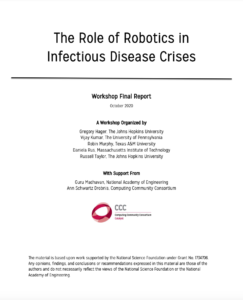 In an effort to prepare for the next pandemic and perhaps aid in the current one, the Computing Community Consortium (CCC), along with the National Academy of Engineering, hosted a virtual workshop entitled Role of Robotics in Infectious Disease Crises on July 9-10, 2020. Organized by Gregory Hager (The Johns Hopkins University), Vijay Kumar (The University of Pennsylvania), Robin Murphy (Texas A&M University), Daniela Rus (Massachusetts Institute of Technology), and Russell Taylor (The Johns Hopkins University), the workshop consisted of over forty participants including representatives from the engineering/robotics community, clinicians, critical care workers, public health and safety experts, and emergency responders. Today we are pleased to release the resulting report The Role of Robotics in Infectious Disease Crises.
In an effort to prepare for the next pandemic and perhaps aid in the current one, the Computing Community Consortium (CCC), along with the National Academy of Engineering, hosted a virtual workshop entitled Role of Robotics in Infectious Disease Crises on July 9-10, 2020. Organized by Gregory Hager (The Johns Hopkins University), Vijay Kumar (The University of Pennsylvania), Robin Murphy (Texas A&M University), Daniela Rus (Massachusetts Institute of Technology), and Russell Taylor (The Johns Hopkins University), the workshop consisted of over forty participants including representatives from the engineering/robotics community, clinicians, critical care workers, public health and safety experts, and emergency responders. Today we are pleased to release the resulting report The Role of Robotics in Infectious Disease Crises.
The recent coronavirus pandemic has highlighted the challenges faced by the healthcare, public safety, and economic systems when confronted with a surge in patients that require intensive treatment and a population that must be quarantined or shelter in place. The most obvious and pressing challenge is taking care of acutely ill patients while managing spread of infection within the care facility. Robotic technologies are inherently programmable, and robotic systems have been adapted and deployed, to some extent, in the current crisis for such purposes as transport, logistics, and disinfection.
This report is the outcome of the workshop and outlines a strategy for increasing national preparedness to use robotic systems and technology in future infectious disease emergencies. It identifies key challenges faced by healthcare responders and the general population and then identifies robotic/technological responses to these challenges. It identifies the key research/knowledge barriers that need to be addressed in developing effective, scalable solutions.
Finally, the report ends with the following recommendations on how to implement this strategy:
- Conduct a full NAE consensus study on the potential for robotic systems to assist in healthcare emergencies and to develop a National Strategy for increasing national preparedness to use robotic systems and technology in future emergencies.
- Conduct scenario planning exercises to “game out” future pandemic crises in order to identify areas where better preparation can facilitate more effective deployment of robotic systems to meet emergent needs.
- Increase research addressing knowledge barriers affecting the capability and mobilization potential of robotic systems.
- Initiate targeted research programs addressing environment-specific knowledge barriers to the deployment of robotic systems in infectious disease settings.
- Develop incentives for translational research to develop novel robotic systems for healthcare applications.
- Institute economic and policy incentives to accelerate adoption of adaptable robotic systems into everyday use by public agencies, particularly healthcare and the medical supply chain industry.
- Establish a consortium focused on robotic systems in infectious-diseases to facilitate connections between roboticists, government, industry, and citizen stakeholders and to provide a clearing house/repository for validated system designs and solutions that can be shared within the community.
See the full report here.









